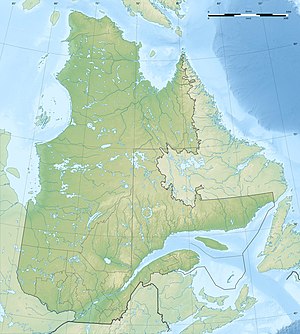Lac Saint-Jean
| Lac Saint-Jean | ||
|---|---|---|

|
||
| Satellite image of Lac Saint-Jean | ||
| Geographical location | Québec (Canada) | |
| Tributaries | Ashuapmushuan , Mistassini , Péribonka , Ticouapé , Métabetchouane , Ouiatchouan | |
| Drain | La Grande Décharge and La Petite Décharge to Saguenay | |
| Places on the shore | Roberval , Alma , Saint-Félicien | |
| Location close to the shore | Saguenay (formerly Chicoutimi and Jonquière ) | |
| Data | ||
| Coordinates | 48 ° 36 ′ N , 72 ° 5 ′ W | |
|
|
||
| Altitude above sea level | 98 m | |
| surface | 1 003 km² | |
| Maximum depth | 63 m | |
The Lac Saint-Jean is a relatively shallow 1,003 square kilometers large and 98 m high altitude lake in the Laurentian mountains of the Canadian province of Quebec , about 160 kilometers west of the St. Lawrence River located in the Saguenay , the outflow of Lac Saint- Jean, near the old colonial settlement of Tadoussac . The lake forms the center of the administrative region Saguenay – Lac-Saint-Jean .
Geography and climate
The lake was previously mistaken for an impact crater . At the end of the last glacial period , about 11500 years ago, the Saguenay region was filled with glacial meltwater . Only after the retreat of the water masses was the connection to the St. Lawrence River and thus to the open sea lost and the freshwater inland waterway formed in its present form.
With its expansions of 43.8 by 24 kilometers and its shore length of 436 km, Lac Saint-Jean is the third largest inland body of water in the province of Québec after Lac Mistassini and Lac à l'Eau Claire . It is fed by many smaller rivers, the majority of which have their source in the north of the Saguenay-Lac-Saint-Jean region, including the Rivière Péribonka , which is the largest tributary of Lac Saint-Jean. Located on the edge of the Canadian shield , surrounded by glacial , medium-high mountains and since the retreat of the cold steppes at the end of the last Ice Age surrounded by boreal forest , the lake is located in a zone of humid continental climates of the effective climate classification Dfb with severe winters and a short but warm one Summer period.
Naming
The original name of Lac Saint-Jean comes from the Innu language , who called it Piékoagami or Pekuakami ("shallow river", "shallow lake"). The lake was later renamed in honor of the Jesuit father Jean de Quen (around 1603-1652) and from now on referred to as Lac Saint-Jean. During his explorations of New France, Jean de Quen came across the shores of Lac Saint-Jean on May 20, 1647 as the first European and immediately set up a mission. The 'Montagnais du Lac St.-Jean' (own designation: Pekuakamiulnuatsh - 'People at Lac Saint-Jean'), like their Innu ancestors, still use the area around the lake to hunt and fish.
nature
Due to its historical connection to the open sea and the gradual regression to an inland waterway, various marine species have gradually adapted to the fresh water and are still at home in Lac Saint-Jean today. These include a subspecies of freshwater salmon ( Salmo salar ), the three-spined stickleback ( Gasterosteus aculeatus ), the "Atlantic tomcod " ( Microgadus tomcod ), also known as frozen fish, a special species of the beach oaf ( Ammophila breveligulata ), which lives on sandy soils , the golden heather ( Hudsonia tomentosa ) and the common pea ( Lathyrus maritimus ).
Web links
- The Saguenay-Lac-Saint-Jean region on the Québec Government website (French)
- Jean de Quen at Canada's National Museum of History and Society , Musée virtuel de la Nouvelle-France, animated map of his expedition to Lac 1647, optionally in English or French.
Individual evidence
- ↑ Natural Resources Canada - The Atlas of Canada - Lakes ( Memento from January 14, 2013 in the Internet Archive )
- ↑ Pekuakamiulnuatsh
